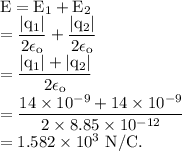
Physics, 14.09.2019 01:10 KHaire2077
Two 2.5-cm-diameter disks face each other, 1.5 mm apart. they are charged to ± 14 nc. part a.
what is the electric field strength between the disks?
express your answer in newtons per coulomb.
part b.
a proton is shot from the negative disk toward the positive disk. what launch speed must the proton have to just barely reach the positive disk?
express your answer in meters per second.

Answers: 1


Another question on Physics

Physics, 22.06.2019 09:30
Which are advantages of renewable resources? check all that apply. renewable energy supplies are completely reliable everywhere. some renewable resources will never be used up. little or no waste is produced by renewable resource plants. electricity can be generated in large quantities. many renewable energy facilities have lower operating costs.
Answers: 1

Physics, 22.06.2019 15:20
Your science teacher brings in a speaker to talk to your class about climate change. during the session, students ask a few questions. which questions are related to the current evidence on climate change
Answers: 3

Physics, 22.06.2019 17:40
The weights of bags filled by a machine are normally distributed with a standard deviation of 0.05 kilograms and a mean that can be set by the operator. at what level should the mean weight be set if it required that only 1% of the bags weigh less than 9.5 kilograms? round the answer to 2 decimal places.
Answers: 1

Physics, 22.06.2019 20:20
The temperature in gavin's oven is a sinusoidal function of time. gavin sets his oven so that it has a maximum temperature of 280°f and a minimum temperature of 240°. once the temperature hits 280°, it takes 20 minutes before it is 280° again. gavin's cake needs to be in the oven for 30 minutes at temperatures at or above 270°. he puts the cake into the oven when it is at 260° and rising. how long will gavin need to leave the cake in the oven? (round your answer to the nearest minute.)
Answers: 3
You know the right answer?
Two 2.5-cm-diameter disks face each other, 1.5 mm apart. they are charged to ± 14 nc. part a.
...
...
Questions

Mathematics, 11.03.2021 20:40



Mathematics, 11.03.2021 20:40


Mathematics, 11.03.2021 20:40

Mathematics, 11.03.2021 20:40




English, 11.03.2021 20:40

English, 11.03.2021 20:40

Mathematics, 11.03.2021 20:40


Mathematics, 11.03.2021 20:40


Mathematics, 11.03.2021 20:40

Mathematics, 11.03.2021 20:40


History, 11.03.2021 20:40



 = electrical permittivity of free space =
= electrical permittivity of free space = 
 Distance between the discs,
Distance between the discs,  Charge on the positive plate,
Charge on the positive plate,  Charge on the negative plate,
Charge on the negative plate, 




 charge on the proton,
charge on the proton, 






